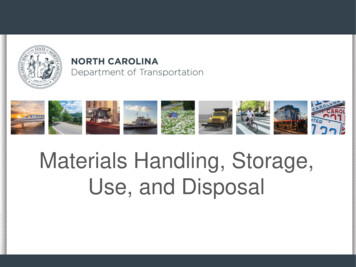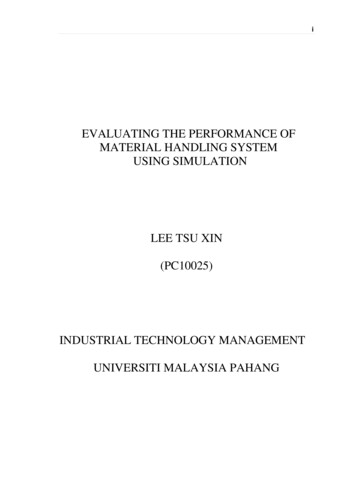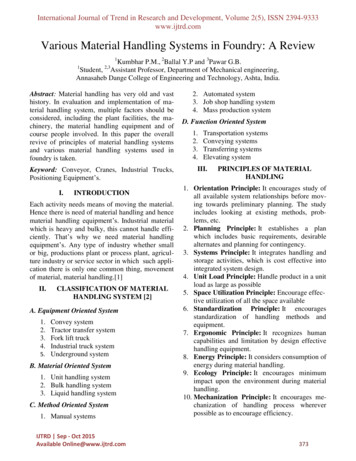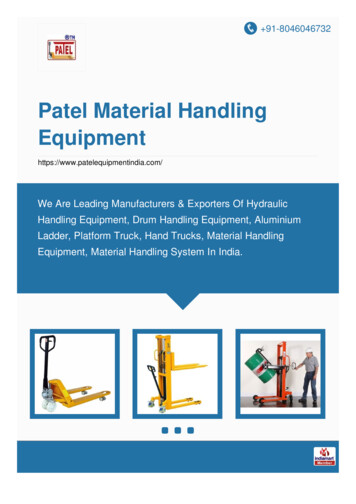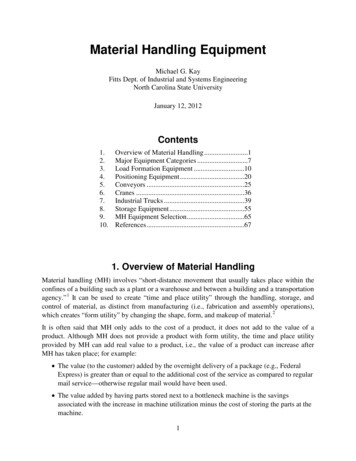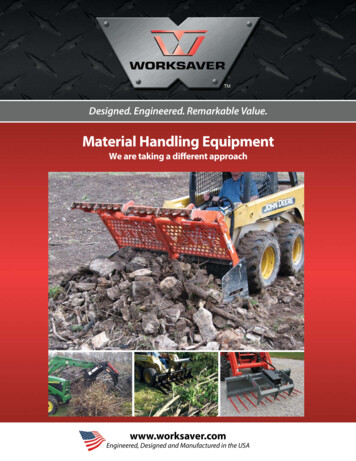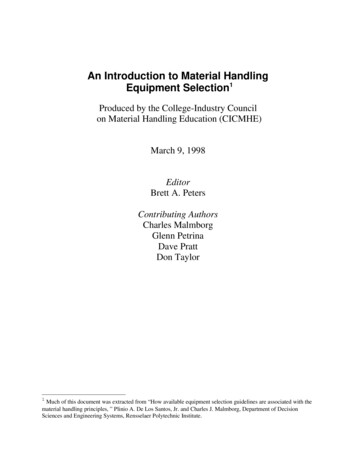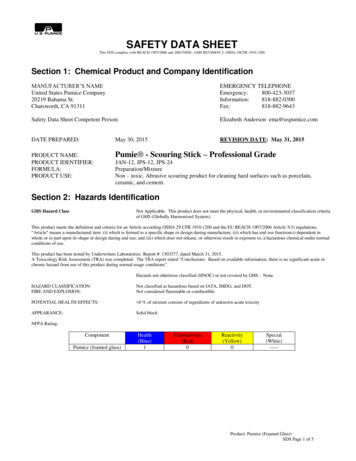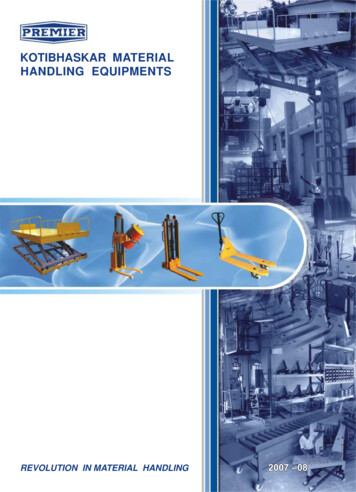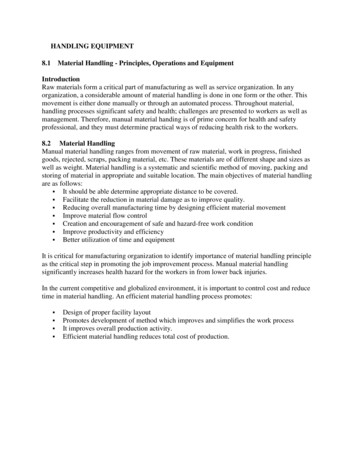
Transcription
HANDLING EQUIPMENT8.1Material Handling - Principles, Operations and EquipmentIntroductionRaw materials form a critical part of manufacturing as well as service organization. In anyorganization, a considerable amount of material handling is done in one form or the other. Thismovement is either done manually or through an automated process. Throughout material,handling processes significant safety and health; challenges are presented to workers as well asmanagement. Therefore, manual material handing is of prime concern for health and safetyprofessional, and they must determine practical ways of reducing health risk to the workers.8.2 Material HandlingManual material handling ranges from movement of raw material, work in progress, finishedgoods, rejected, scraps, packing material, etc. These materials are of different shape and sizes aswell as weight. Material handling is a systematic and scientific method of moving, packing andstoring of material in appropriate and suitable location. The main objectives of material handlingare as follows: It should be able determine appropriate distance to be covered. Facilitate the reduction in material damage as to improve quality. Reducing overall manufacturing time by designing efficient material movement Improve material flow control Creation and encouragement of safe and hazard-free work condition Improve productivity and efficiency Better utilization of time and equipmentIt is critical for manufacturing organization to identify importance of material handling principleas the critical step in promoting the job improvement process. Manual material handlingsignificantly increases health hazard for the workers in from lower back injuries.In the current competitive and globalized environment, it is important to control cost and reducetime in material handling. An efficient material handling process promotes: Design of proper facility layoutPromotes development of method which improves and simplifies the work processIt improves overall production activity.Efficient material handling reduces total cost of production.
8.3PRINCIPLES OF MATERIAL HANDLINGMaterial handling principles are as follows: Orientation Principle: It encourages study of all available system relationships beforemoving towards preliminary planning. The study includes looking at existing methods,problems, etc.Planning Principle: It establishes a plan which includes basic requirements, desirablealternates and planning for contingency.Systems Principle: It integrates handling and storage activities, which is cost effectiveinto integrated system design.Unit Load Principle: Handle product in a unit load as large as possibleSpace Utilization Principle: Encourage effective utilization of all the space availableStandardization Principle: It encourages standardization of handling methods andequipment.Ergonomic Principle: It recognizes human capabilities and limitation by designeffective handling equipment.Energy Principle: It considers consumption of energy during material handling.Ecology Principle: It encourages minimum impact upon the environment during materialhandling.Mechanization Principle: It encourages mechanization of handling process whereverpossible as to encourage efficiency.Flexibility Principle: Encourages of methods and equipment which are possible toutilize in all types of condition.Simplification Principle: Encourage simplification of methods and process by removingunnecessary movementsGravity Principle: Encourages usage of gravity principle in movement of goods.Safety Principle: Encourages provision for safe handling equipment according to safetyrules and regulationComputerization Principle: Encourages of computerization of material handling andstorage systemsSystem Flow Principle: Encourages integration of data flow with physical material flowLayout Principle: Encourages preparation of operational sequence of all systemsavailableCost Principle: Encourages cost benefit analysis of all solutions availableMaintenance Principle: Encourages preparation of plan for preventive maintenance andscheduled repairsObsolescence Principle: Encourage preparation of equipment policy as to enjoyappropriate economic advantage.Material handling operations are designed based upon principles as discussed above. Materialhandling equipment consists of cranes, conveyors and industrial trucks.
8.4DISCUSSION ON TEN MAJOR PRINCIPLES OF MATERIAL HANDLING(1) PLANNING PRINCIPLEAll material handling should be the result of a deliberate plan where the needs, performanceobjectives and functional specification of the proposed methods are completely defined at theoutset.Definition: A plan is a prescribed course of action that is defined in advance of implementation.In its simplest form a material handing plan defines the material (what) and the moves (whenand where); together they define the method (how and who).Very important points: The plan should be developed in consultation between the planner(s) and all who will useand benefit from the equipment to be employed. Success in planning large scale material handling projects generally requires a teamapproach involving suppliers, consultants when appropriate, and end user specialists frommanagement, engineering, computer and information systems, finance and operations. The material handling plan should reflect the strategic objectives of the organization aswell as the more immediate needs. The plan should document existing methods and problems, physical and economicconstraints, and future requirements and goals. The plan should promote concurrent engineering of product, process design, processlayout, and material handling methods, as opposed to independent and sequential designpractices.(2) STANDARDIZATION PRINCIPLEMaterial handling methods, equipment, controls and software should be standardized within thelimits of achieving overall performance objectives and without sacrificing needed flexibility,modularity and throughput .anticipation of changing future requirementsDefinition: Standardization means less variety and customization in the methods and equipmentemployed.Very important points: The planner should select methods and equipment that can perform a variety of tasksunder a variety of operating conditions and in Standardization applies to sizes of containers and other load forming components as wellas operating procedures and equipment. Standardization, flexibility and modularity must not be incompatible. (3) WORK PRINCIPLEMaterial handling work should be minimized without sacrificing productivity or the level ofservice required of the operation.Definition: The measure of work is material handling flow (volume, weight or count per unit oftime) multiplied by the distance moved.Very important points: Simplifying processes by reducing, combining, shortening or eliminating unnecessarymoves will reduce work.
Consider each pickup and set-down, or placing material in and out of storage, as distinctmoves and components of the distance moved.Process methods, operation sequences and process/equipment layouts should be preparedthat support the work minimization objective.Where possible, gravity should be used to move materials or to assist in their movementwhile respecting consideration of safety and the potential for product damage.The shortest distance between two points is a straight line.(4) ERGONOMIC PRINCIPLEHuman capabilities and limitations must be recognized and respected in the design of materialhandling tasks and equipment to ensure safe and effective operations.Definition: Ergonomics is the science that seeks to adapt work or working conditions to suit theabilities of the worker.Very important points: Equipment should be selected that eliminates repetitive and strenuous manual labor andwhich effectively interacts with human operators and users. The ergonomic principle embraces both physical and mental tasks. The material handling workplace and the equipment employed to assist in that work mustbe designed so they are safe for people(5) UNIT LOAD PRINCIPLEUnit loads shall be appropriately sized and configured in a way which achieves the material flowand inventory objectives at each stage in the supply chain.Definition: A unit load is one that can be stored or moved as a single entity at one time, such asa pallet, container or tote, regardless of the number of individual items that make up the load.Very important points: Less effort and work is required to collect and move many individual items as a singleload than to move many items one at a time. Load size and composition may change as material and product moves through stages ofmanufacturing and the resulting distribution channels. Large unit loads are common both pre and post manufacturing in the form of rawmaterials and finished goods. During manufacturing, smaller unit loads, including as few as one item, yield less inprocess inventory and shorter item throughput times. Smaller unit loads are consistent with manufacturing strategies that embrace operatingobjectives such as flexibility, continuous flow and just-in-time delivery. Unit loads composed of a mix of different items are consistent with just-in-time and/orcustomized supply strategies so long as item selectivity is not compromised.
(6)SPACE UTILIZATION PRINCIPLEEffective and efficient use must be made of all available space.Definition: Space in material handling is three dimensional and therefore is counted as cubicspace.Very important points: In work areas, cluttered and unorganized spaces and blocked aisles should be eliminated. In storage areas, the objective of maximizing storage density must be balanced againstaccessibility and selectivity. When transporting loads within a facility the use of overhead space should be consideredas an option.(7)SYSTEM PRINCIPLEMaterial movement and storage activities should be fully integrated to form a coordinated,operational system which spans receiving, inspection, storage, production, assembly, packaging,unitizing, order selection, shipping, transportation and the handling of returns.Definition: A system is a collection of interacting and/or interdependent entities that form aunified whole.Very important points: Systems integration should encompass the entire supply chain including reverse logistics.It should include suppliers, manufacturers, distributors and customers. Inventory levels should be minimized at all stages of production and distribution whilerespecting considerations of process variability and customer service. Information flow and physical material flow should be integrated and treated asconcurrent activities Methods should be provided for easily identifying materials and products, fordetermining their location and status within facilities and within the supply chain and forcontrolling their movement. Customer requirements and regarding quantity, quality, and on-time delivery should bemet without exception. Consistency and predictability, regarding quantity, quality, andon-time delivery should be met without exception.(8)AUTOMATION PRINCIPLEMaterial handling operations should be mechanized and/or automated where feasible to improveoperational efficiency, increase responsiveness, improve consistency and predictabilVery important points: Pre-existing processes and methods should be simplified and/or re-engineered before anyefforts at installing mechanized or automated systems. Computerized material handling systems should be considered where appropriate foreffective integration of material flow and information management. Treat all interface issues as critical to successful automation, including equipment toequipment, equipment to load, equipment to operator, and control communications. All items expected to be handled automatically must have features that accommodatemechanized and automated handling.
(9)ENVIRONMENTAL PRINCIPLEEnvironmental impact and energy consumption should be considered as criteria when designingor selecting alternative equipment and material handling systems.Definition: Environmental consciousness stems from a desire not to waste natural resources andto predict and eliminate the possible negative effects of our daily actions on the environment.Very important points: Containers, pallets and other products used to form and protect unit loads should bedesigned for reusability when possible and/or biodegradability as appropriate. Systems design should accommodate the handling of spent dun age, empty containersand other by-products of material handling. Materials specified as hazardous have special needs with regard to spill protection,combustibility and other risks.(10)LIFE CYCLE COST PRINCIPLEA thorough economic analysis should account for the entire life cycle of all material handlingequipment and resulting systems.Definition: Life cycle costs include all cash flows that will occur between the time the first dollaris spent to plan or procure a new piece of equipment, or to put in place a new method, until thatmethod and/or equipment is totally replaced.Very important points: Life cycle costs include capital investment, installation, setup and equipmentprogramming, training, system testing and acceptance, operating (labor, utilities, etc.),maintenance and repair, reuse value, and ultimate disposal. A plan for preventive and predictive maintenance should be prepared for the equipment,and the estimated cost of maintenance and spare parts should be included in the economicanalysis. A long-range plan for replacement of the equipment when it becomes obsolete should beprepared. Although measurable cost is a primary factor, it is certainly not the only factor inselecting among alternatives. Other factors of a strategic nature to the organization andwhich form the basis for competition in the market place should be considered andquantified whenever possible.8.5 Major Equipment CategoriesOld adage (that applies to a lack of MH equipment knowledge): ―If the only tool you have is ahammer, it’s amazing how quickly all your problems seem to look like nails.‖The different types of MH equipment listed can be classified into the following five majorcategories:I. Transport Equipment. Equipment used to move material from one location to another (e.g.,between workplaces, between a loading dock and a storage area, etc.). The major subcategoriesof transport equipment are conveyors, cranes, and industrial trucks. Material can also betransported manually using no equipment.II. Positioning Equipment. Equipment used to handle material at a single location (e.g., to feedand/or manipulate materials so that are in the correct position for subsequent handling,machining, transport, or storage). Unlike transport equipment, positioning equipment is usually
used for handling at a single workplace. Material can also be positioned manually using noequipment.III. Unit Load Formation Equipment. Equipment used to restrict materials so that they maintaintheir integrity when handled a single load during transport and for storage. If materials are selfrestraining (e.g., a single part or interlocking parts), then they can be formed into a unit load withno equipment.IV. Storage Equipment. Equipment used for holding or buffering materials over a period of time.Some storage equipment may include the transport of materials (e.g., the S/R machines of anAS/RS, or storage carousels). If materials are block stacked directly on the floor, then no storageequipment is required.V. Identification and Control Equipment. Equipment used to collect and communicate theinformation that is used to coordinate the flow of materials within a facility and between afacility and its suppliers and customers. The identification of materials and associated control canbe performed manually with no specialized equipment.1. Load Formation EquipmentUnit load formation equipment is used to restrict materials so that they maintain their integritywhen handled a single load during transport and for storage. If materials are self-restraining (e.g.,a single part or interlocking parts), then they can be formed into a unit load with no equipment.2. Self-restraining (no equipment)One or more items that can maintain their integrity when handled as a single item (e.g., a single part orinterlocking parts)3. PalletsPlatform with enough clearance beneath its top surface (or face) to enable the insertion of forks forsubsequent lifting purposesMaterials: Wood (most common), paper, plastic, rubber, and metal Size of pallet is specified by its depth(i.e., length of its stringers or stringer boards) and its width(i.e., length its deck boards)—pallet height(typically 5 in.) is usually not specified.Orientation of stringers relative to deck boards of pallet is specified by always listing its depth first andwidth last: Depth (stringer length) Width (deck board length)48 40 in. pallet is most popular in the US (27% of all pallets—no other size over 5%) becauseits compatibility with railcar and truck trailer dimensions; e.g., the GMA (Grocery Manufacturers of America)pallet is four-way and made of hardwood 1200 800 mm ―Euro-Pallet‖ is the standard pallet in EuropeSingle-face pallets are sometimes referred to as ―skids‖
Fig. 8 Pallet4. SkidsPlatform (typically metal) with enough clearance beneath its top surface to enable a platform truck tomove underneath for subsequent lifting purposesForks can also be used to handle skids since the clearance of a skid is greater than that of a palletCompared to a pallet, a skid is usually used for heavier loads and when stacking is not requiredA metal skid can lift heavier loads than an equal-weight metal pallet because it enables a platform truck tobe used for the lifting, with the platform providing a greater lifting surface to support the skid as comparedto the forks used to support the palletFig. 9 Skid5. Slip-sheetsThick piece of paper, corrugated fiber, or plastic upon which a load is placedHandling method: tabs on the sheet are grabbed by a special push/pull lift truck attachmentAdvantages: usually used in place of a pallet for long-distance shipping because their costis 10–30% of pallet costs and their weight and volume is 1–5% of a palletDisadvantages: slower handling as compared to pallets; greater load damage within the facility; speciallift truck attachment reduces the vehicle’s load capacity
Fig. 10 Slip - Sheet6. Tote pansReusable container used to unitize and protect loose discreteitemsTypically used for in-process handlingReturnable totes provide alternative to cartons for distributionCan be nested for compact storage when not in useFig. 11 Tote pan6. Pallet/skid boxesReusable containers used to unitize andprotect loose items for fork/platformtruck handling Pallet box sometimesreferred to as a ―bin7. CartonsDisposable container used to unitize and protect loose discrete items. Typically used fordistribution. Dimensions always specified as sequence: Length Width Depth, where length isthe larger, and width is the smaller, of the two dimension of the open face of the carton, anddepth is the distance perpendicular to the length and width
Large quantities of finished carton blanks or knocked-down cartons can be stored on pallets untilneeded.Fig. 12 Carton
HANDLING EQUIPMENT 8.1 Material Handling - Principles, Operations and Equipment Introduction Raw materials form a critical part of manufacturing as well as service organization. In any organization, a considerable amount of material handling is done in one form or the other. This movement is either done manually or through an automated process.
